YAMAHA XENTER 150 2016 User Guide
Manufacturer: YAMAHA, Model Year: 2016, Model line: XENTER 150, Model: YAMAHA XENTER 150 2016Pages: 84, PDF Size: 1.88 MB
Page 11 of 84

Safety information
1-4
12
3
4
5
6
7
8
9
10
11
12
Aftermarket Parts, Accessories,
and Modifications
While you may find aftermarket prod-
ucts similar in design and quality to
genuine Yamaha accessories, recog-
nize that some aftermarket accessories
or modifications are not suitable be-
cause of potential safety hazards to you
or others. Installing aftermarket prod-
ucts or having other modifications per-
formed to your vehicle that change any
of the vehicle’s design or operation
characteristics can put you and others
at greater risk of serious injury or death.
You are responsible for injuries related
to changes in the vehicle.
Keep the following guidelines in mind,
as well as those provided under “Load-
ing” when mounting accessories.
Never install accessories or carry
cargo that would impair the perfor-
mance of your scooter. Carefully
inspect the accessory before using
it to make sure that it does not in
any way reduce ground clearance
or cornering clearance, limit sus-
pension travel, steering travel or
control operation, or obscure lights
or reflectors. Accessories fitted to the handle-
bar or the front fork area can
create instability due to improper
weight distribution or aerody-
namic changes. If accessories
are added to the handlebar or
front fork area, they must be as
lightweight as possible and
should be kept to a minimum.
Bulky or large accessories may seriously affect the stability of
the scooter due to aerodynamic
effects. Wind may attempt to lift
the scooter, or the scooter may
become unstable in cross
winds. These accessories may
also cause instability when
passing or being passed by
large vehicles.
Certain accessories can dis- place the operator from his or
her normal riding position. This
improper position limits the free-
dom of movement of the opera-
tor and may limit control ability,
therefore, such accessories are
not recommended.
Use caution when adding electri-
cal accessories. If electrical acces- sories exceed the capacity of the
scooter’s electrical system, an
electric failure could result, which
could cause a dangerous loss of
lights or engine power.
Aftermarket Tires and Rims
The tires and rims that came with your
scooter were designed to match the
performance capabilities and to provide
the best combination of handling, brak-
ing, and comfort. Other tires, rims, siz-
es, and combinations may not be
appropriate. Refer to page 6-18 for tire
specifications and more information on
replacing your tires.
Transporting the Scooter
Be sure to observe following instruc-
tions before transporting the scooter in
another vehicle.
Remove all loose items from the
scooter.
Point the front wheel straight
ahead on the trailer or in the truck
bed, and choke it in a rail to pre-
vent movement.
Secure the scooter with tie-downs
or suitable straps that are attached
U52SE1E0 4 ページ 2015年9月16日 水曜日 午後5時27分
Page 12 of 84

Safety information
1-5
1
2
3
4
5
6
7
8
9
10
11
12 to solid parts of the scooter, such
as the frame or upper front fork tri-
ple clamp (and not, for example, to
rubber-mounted handlebars or
turn signals, or parts that could
break). Choose the location for the
straps carefully so the straps will
not rub against painted surfaces
during transport.
The suspension should be com-
pressed somewhat by the
tie-downs, if possible, so that the
scooter will not bounce excessive-
ly during transport.
EAU57600
Further safe-riding points
Be sure to signal clearly when
making turns.
Braking can be extremely difficult
on a wet road. Avoid hard braking,
because the scooter could slide.
Apply the brakes slowly when
stopping on a wet surface.
Slow down as you approach a cor-
ner or turn. Once you have com-
pleted a turn, accelerate slowly.
Be careful when passing parked
cars. A driver might not see you
and open a door in your path.
Railroad crossings, streetcar rails,
iron plates on road construction
sites, and manhole covers be-
come extremely slippery when
wet. Slow down and cross them
with caution. Keep the scooter up-
right, otherwise it could slide out
from under you.
The brake pads or linings could get
wet when you wash the scooter.
After washing the scooter, check
the brakes before riding.
Always wear a helmet, gloves,
trousers (tapered around the cuff and ankle so they do not flap), and
a brightly colored jacket.
Do not carry too much luggage on
the scooter. An overloaded scoot-
er is unstable. Use a strong cord to
secure any luggage to the carrier
(if equipped). A loose load will af-
fect the stability of the scooter and
could divert your attention from the
road. (See page 1-3.)
U52SE1E0 5 ページ 2015年9月16日 水曜日 午後5時27分
Page 13 of 84
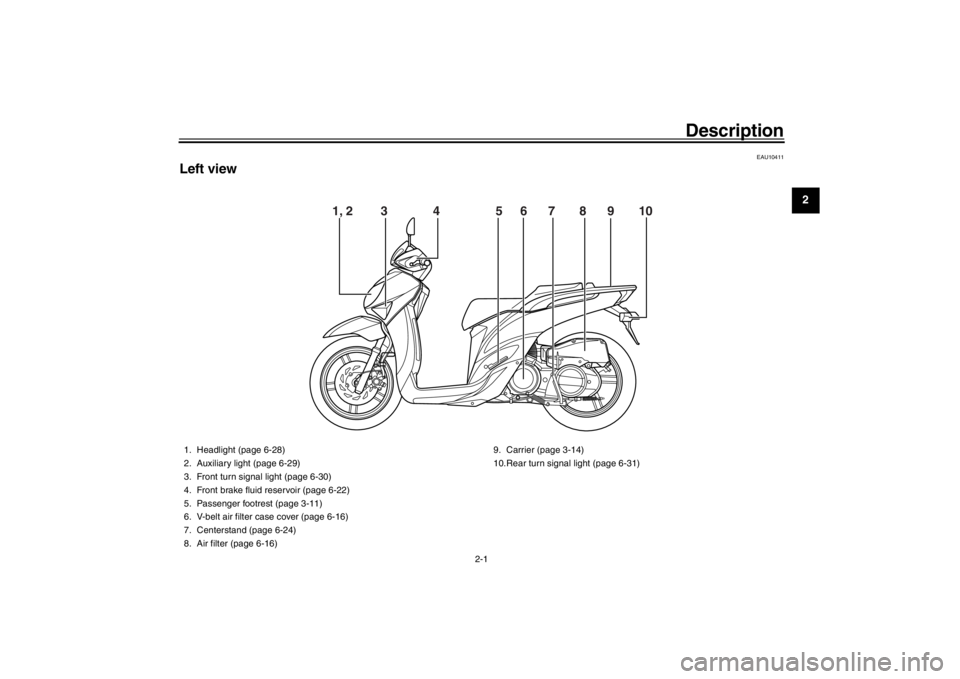
2-1
123
4
5
6
7
8
9
10
11
12
Description
EAU10411
Left view
1, 2 3 4 5 6 7 8 9 \
10
1. Headlight (page 6-28)
2. Auxiliary light (page 6-29)
3. Front turn signal light (page 6-30)
4. Front brake fluid reservoir (page 6-22)
5. Passenger footrest (page 3-11)
6. V-belt air filter case cover (page 6-16)
7. Centerstand (page 6-24)
8. Air filter (page 6-16) 9. Carrier (page 3-14)
10.Rear turn signal light (page 6-31)
U52SE1E0 1 ページ 2015年9月16日 水曜日 午後5時27分
Page 14 of 84
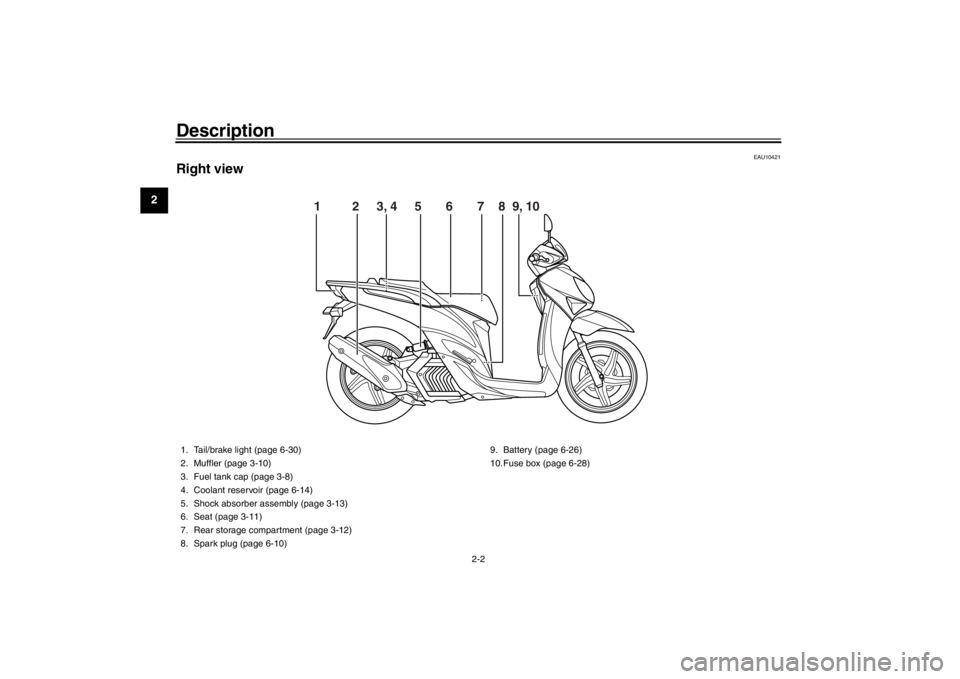
Description
2-2
12
3
4
5
6
7
8
9
10
11
12
EAU10421
Right view
1 2 3, 4 5 6 7 8 9, 10
1. Tail/brake light (page 6-30)
2. Muffler (page 3-10)
3. Fuel tank cap (page 3-8)
4. Coolant reservoir (page 6-14)
5. Shock absorber assembly (page 3-13)
6. Seat (page 3-11)
7. Rear storage compartment (page 3-12)
8. Spark plug (page 6-10) 9. Battery (page 6-26)
10.Fuse box (page 6-28)
U52SE1E0 2 ページ 2015年9月16日 水曜日 午後5時27分
Page 15 of 84
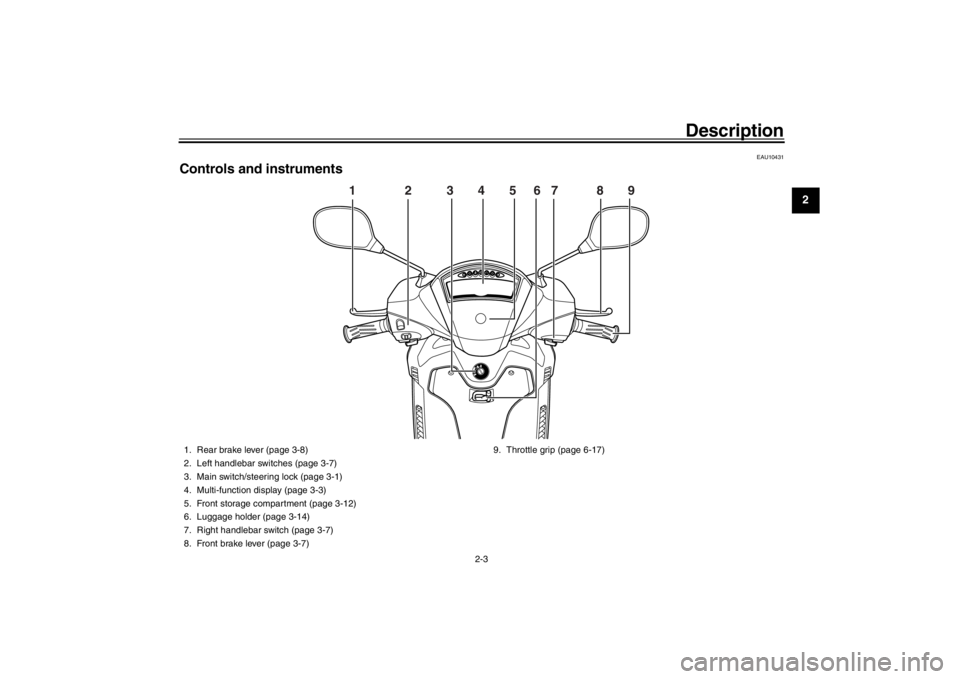
Description
2-3
123
4
5
6
7
8
9
10
11
12
EAU10431
Controls and instruments
1 2 3 4 5 6 7 8 \
9
1. Rear brake lever (page 3-8)
2. Left handlebar switches (page 3-7)
3. Main switch/steering lock (page 3-1)
4. Multi-function display (page 3-3)
5. Front storage compartment (page 3-12)
6. Luggage holder (page 3-14)
7. Right handlebar switch (page 3-7)
8. Front brake lever (page 3-7) 9. Throttle grip (page 6-17)
U52SE1E0 3 ページ 2015年9月16日 水曜日 午後5時27分
Page 16 of 84
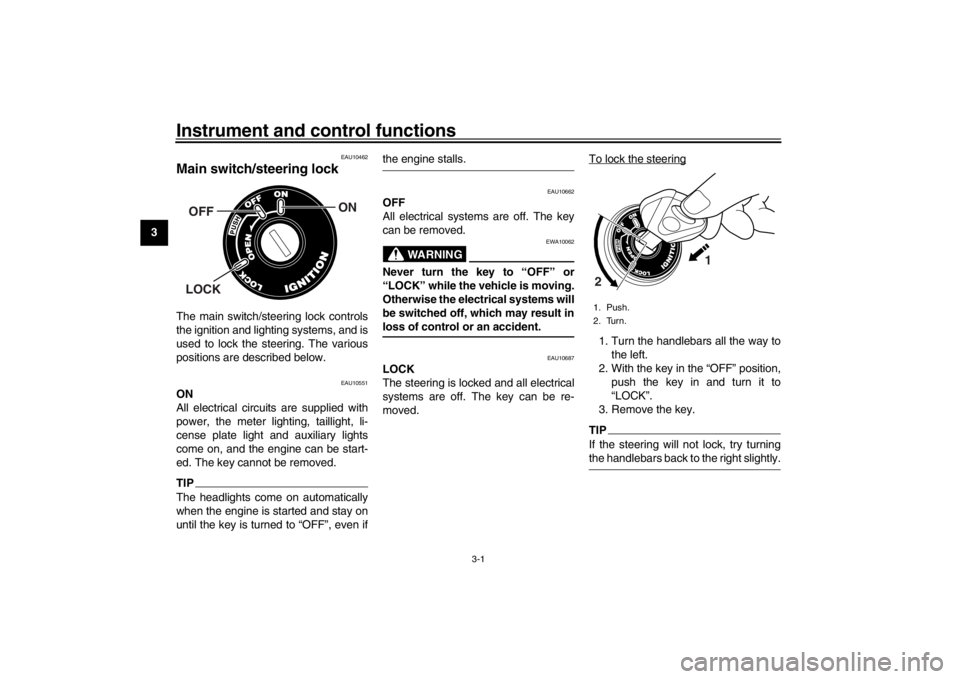
3-1
1
23
4
5
6
7
8
9
10
11
12
Instrument and control functions
EAU10462
Main switch/steering lockThe main switch/steering lock controls
the ignition and lighting systems, and is
used to lock the steering. The various
positions are described below.
EAU10551
ON
All electrical circui ts are supplied with
power, the meter lighting, taillight, li-
cense plate light and auxiliary lights
come on, and the engine can be start-
ed. The key cannot be removed.TIPThe headlights come on automatically
when the engine is started and stay on
until the key is turned to “OFF”, even if
the engine stalls.
EAU10662
OFF
All electrical systems are off. The key
can be removed.
WARNING
EWA10062
Never turn the key to “OFF” or
“LOCK” while the vehicle is moving.
Otherwise the electrical systems will
be switched off, which may result inloss of control or an accident.
EAU10687
LOCK
The steering is lock ed and all electrical
systems are off. The key can be re-
moved. To lock the steering
1. Turn the handlebars all the way to
the left.
2. With the key in the “OFF” position, push the key in and turn it to
“LOCK”.
3. Remove the key.TIPIf the steering will not lock, try turningthe handlebars back to the right slightly.
ON
OFFLOCK
1. Push.
2. Turn.
1
2
U52SE1E0 1 ページ 2015年9月16日 水曜日 午後5時27分
Page 17 of 84
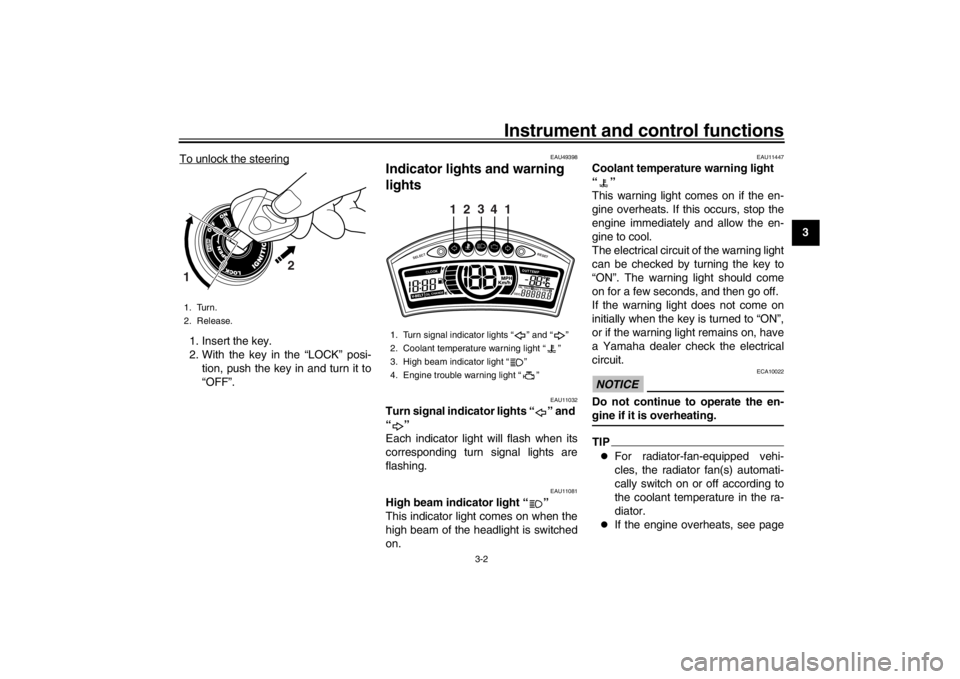
Instrument and control functions
3-2
1
234
5
6
7
8
9
10
11
12
To unlock the steering
1. Insert the key.
2. With the key in the “LOCK” posi-
tion, push the key in and turn it to
“OFF”.
EAU49398
Indicator lights and warning
lights
EAU11032
Turn signal indicator lights “ ” and
“”
Each indicator light will flash when its
corresponding turn signal lights are
flashing.
EAU11081
High beam indicator light “ ”
This indicator light comes on when the
high beam of the headlight is switched
on.
EAU11447
Coolant temperature warning light
“”
This warning light comes on if the en-
gine overheats. If this occurs, stop the
engine immediately and allow the en-
gine to cool.
The electrical circuit of the warning light
can be checked by turning the key to
“ON”. The warning light should come
on for a few seconds, and then go off.
If the warning light does not come on
initially when the key is turned to “ON”,
or if the warning light remains on, have
a Yamaha dealer check the electrical
circuit.NOTICE
ECA10022
Do not continue to operate the en-gine if it is overheating.TIP
For radiator-fan-equipped vehi-
cles, the radiator fan(s) automati-
cally switch on or off according to
the coolant temperature in the ra-
diator.
If the engine overheats, see page
1. Turn.
2. Release.
2
1
1. Turn signal indicator lights “ ” and “ ”
2. Coolant temperature warning light “ ”
3. High beam indicator light “ ”
4. Engine trouble warning light “ ”
SELECT
RESET
ODOOIL TRI P 1 BE LT TRI P 2
OIL CHANGECLOOK
OUT TEM P
3
24
11
U52SE1E0 2 ページ 2015年9月16日 水曜日 午後5時27分
Page 18 of 84
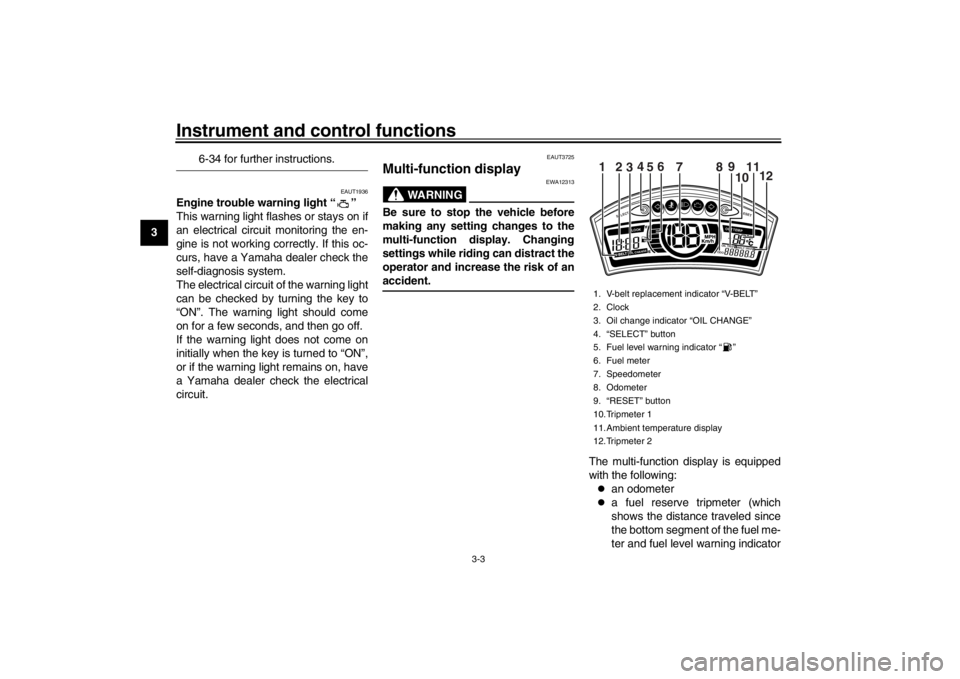
Instrument and control functions
3-3
1
23
4
5
6
7
8
9
10
11
12
6-34 for further instructions.
EAUT1936
Engine trouble warning light “ ”
This warning light flashes or stays on if
an electrical circuit monitoring the en-
gine is not working correctly. If this oc-
curs, have a Yamaha dealer check the
self-diagnosis system.
The electrical circuit of the warning light
can be checked by turning the key to
“ON”. The warning light should come
on for a few seconds, and then go off.
If the warning light does not come on
initially when the key is turned to “ON”,
or if the warning light remains on, have
a Yamaha dealer check the electrical
circuit.
EAUT3725
Multi-function display
WARNING
EWA12313
Be sure to stop the vehicle before
making any setting changes to the
multi-function display. Changing
settings while riding can distract the
operator and increase the risk of anaccident.
The multi-function display is equipped
with the following:
an odometer
a fuel reserve tripmeter (which
shows the distance traveled since
the bottom segment of the fuel me-
ter and fuel level warning indicator
1. V-belt replacement indicator “V-BELT”
2. Clock
3. Oil change indicator “OIL CHANGE”
4. “SELECT” button
5. Fuel level warning indicator “ ”
6. Fuel meter
7. Speedometer
8. Odometer
9. “RESET” button
10.Tripmeter 1
11.Ambient temperature display
12.Tripmeter 2
SELECT
RESET
ODOOIL
TRI P 1 BE LT TRI P
2
OIL CHANGECLOOK
OUT TEM P
12
34
5 6
78 9
10 12
11
U52SE1E0 3 ページ 2015年9月16日 水曜日 午後5時27分
Page 19 of 84
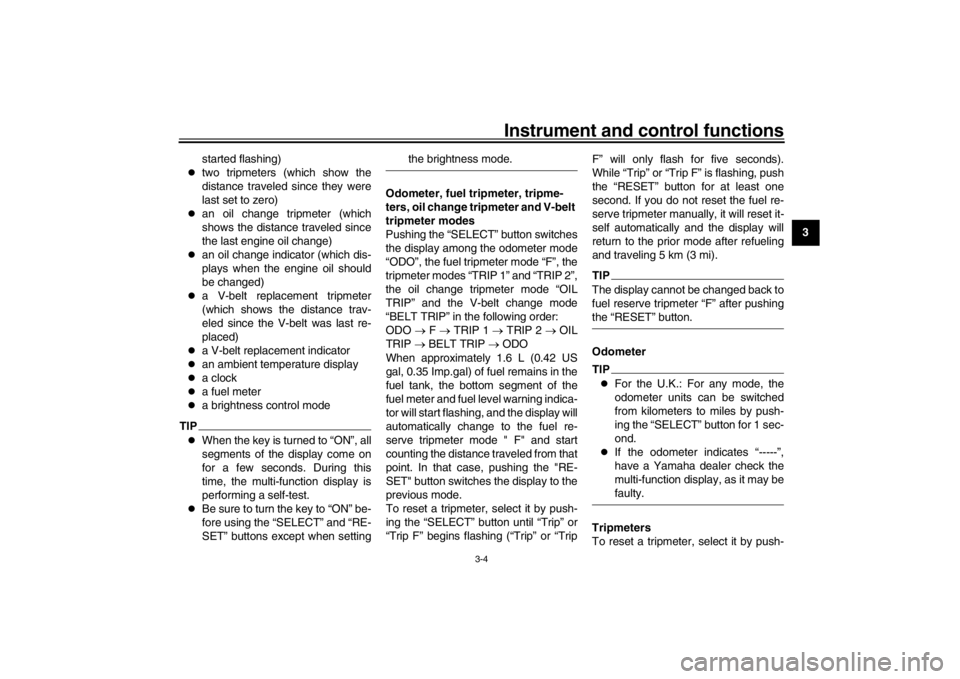
Instrument and control functions
3-4
1
234
5
6
7
8
9
10
11
12
started flashing)
two tripmeters (which show the
distance traveled since they were
last set to zero)
an oil change tripmeter (which
shows the distance traveled since
the last engine oil change)
an oil change indicator (which dis-
plays when the engine oil should
be changed)
a V-belt replacement tripmeter
(which shows the distance trav-
eled since the V-belt was last re-
placed)
a V-belt replacement indicator
an ambient temperature display
a clock
a fuel meter
a brightness control mode
TIP
When the key is turned to “ON”, all
segments of the display come on
for a few seconds. During this
time, the multi-function display is
performing a self-test.
Be sure to turn the key to “ON” be-
fore using the “SELECT” and “RE-
SET” buttons except when setting
the brightness mode.
Odometer, fuel tripmeter, tripme-
ters, oil change tripmeter and V-belt
tripmeter modes
Pushing the “SELECT” button switches
the display among the odometer mode
“ODO”, the fuel tripmeter mode “F”, the
tripmeter modes “TRIP 1” and “TRIP 2”,
the oil change tripmeter mode “OIL
TRIP” and the V-belt change mode
“BELT TRIP” in the following order:
ODO F TRIP 1 TRIP 2 OIL
TRIP BELT TRIP ODO
When approximately 1.6 L (0.42 US
gal, 0.35 Imp.gal) of fuel remains in the
fuel tank, the bottom segment of the
fuel meter and fuel level warning indica-
tor will start flashing, and the display will
automatically change to the fuel re-
serve tripmeter mode " F" and start
counting the distance traveled from that
point. In that case, pushing the "RE-
SET" button switches the display to the
previous mode.
To reset a tripmeter, select it by push-
ing the “SELECT” button until “Trip” or
“Trip F” begins flashing (“Trip” or “Trip F” will only flash for five seconds).
While “Trip” or “Trip F” is flashing, push
the “RESET” button for at least one
second. If you do not reset the fuel re-
serve tripmeter manually, it will reset it-
self automatically and the display will
return to the prior mode after refueling
and traveling 5 km (3 mi).
TIPThe display cannot be changed back to
fuel reserve tripmeter “F” after pushingthe “RESET” button.
OdometerTIP
For the U.K.: For any mode, the
odometer units can be switched
from kilometers to miles by push-
ing the “SELECT” button for 1 sec-
ond.
If the odometer indicates “-----”,
have a Yamaha dealer check the
multi-function display, as it may befaulty.
Tripmeters
To reset a tripmeter, select it by push-
U52SE1E0 4 ページ 2015年9月16日 水曜日 午後5時27分
Page 20 of 84
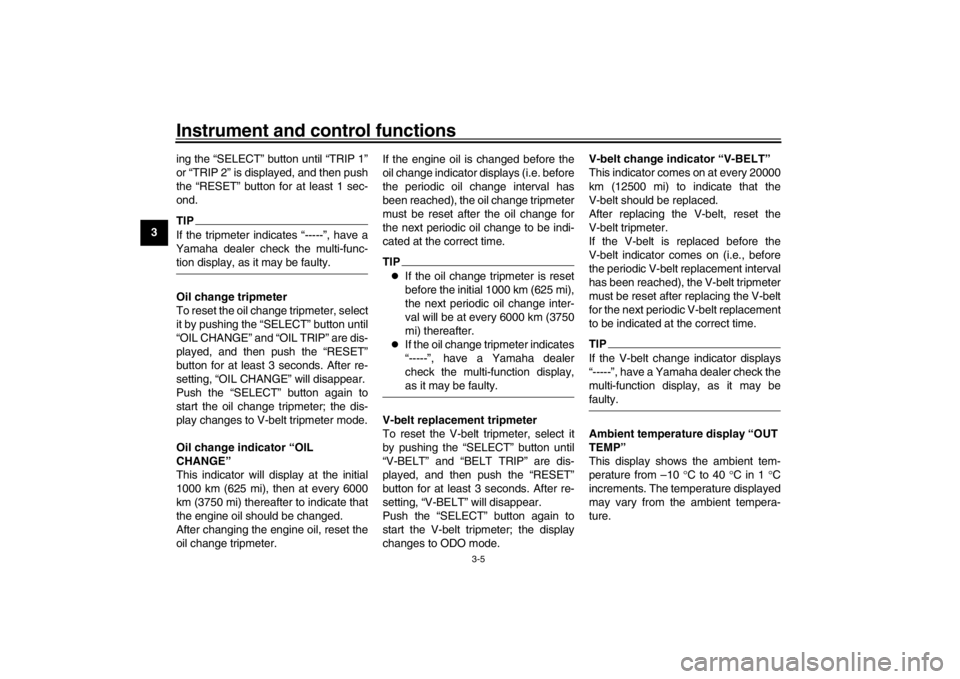
Instrument and control functions
3-5
1
23
4
5
6
7
8
9
10
11
12 ing the “SELECT” button until “TRIP 1”
or “TRIP 2” is displayed, and then push
the “RESET” button for at least 1 sec-
ond.
TIPIf the tripmeter indicates “-----”, have a
Yamaha dealer check the multi-func-tion display, as it may be faulty.
Oil change tripmeter
To reset the oil change tripmeter, select
it by pushing the “SELECT” button until
“OIL CHANGE” and “OIL TRIP” are dis-
played, and then push the “RESET”
button for at least 3 seconds. After re-
setting, “OIL CHANGE” will disappear.
Push the “SELECT” button again to
start the oil change tripmeter; the dis-
play changes to V-belt tripmeter mode.
Oil change indicator “OIL
CHANGE”
This indicator will display at the initial
1000 km (625 mi), then at every 6000
km (3750 mi) thereafter to indicate that
the engine oil should be changed.
After changing the engine oil, reset the
oil change tripmeter. If the engine oil is changed before the
oil change indicator displays (i.e. before
the periodic oil change interval has
been reached), the oil change tripmeter
must be reset after the oil change for
the next periodic oil change to be indi-
cated at the correct time.
TIP
If the oil change tripmeter is reset
before the initial 1000 km (625 mi),
the next periodic oil change inter-
val will be at every 6000 km (3750
mi) thereafter.
If the oil change tripmeter indicates
“-----”, have a Yamaha dealer
check the multi-function display,as it may be faulty.
V-belt replacement tripmeter
To reset the V-belt tripmeter, select it
by pushing the “SELECT” button until
“V-BELT” and “BELT TRIP” are dis-
played, and then push the “RESET”
button for at least 3 seconds. After re-
setting, “V-BELT” will disappear.
Push the “SELECT” button again to
start the V-belt tripmeter; the display
changes to ODO mode. V-belt change indicator “V-BELT”
This indicator comes on at every 20000
km (12500 mi) to indicate that the
V-belt should be replaced.
After replacing the V-belt, reset the
V-belt tripmeter.
If the V-belt is replaced before the
V-belt indicator comes on (i.e., before
the periodic V-belt replacement interval
has been reached), the V-belt tripmeter
must be reset after replacing the V-belt
for the next periodic V-belt replacement
to be indicated at the correct time.
TIPIf the V-belt change indicator displays
“-----”, have a Yamaha dealer check the
multi-function display, as it may befaulty.
Ambient temperature display “OUT
TEMP”
This display shows the ambient tem-
perature from –10
C to 40 C in 1 C
increments. The temperature displayed
may vary from the ambient tempera-
ture.
U52SE1E0 5 ページ 2015年9月16日 水曜日 午後5時27分